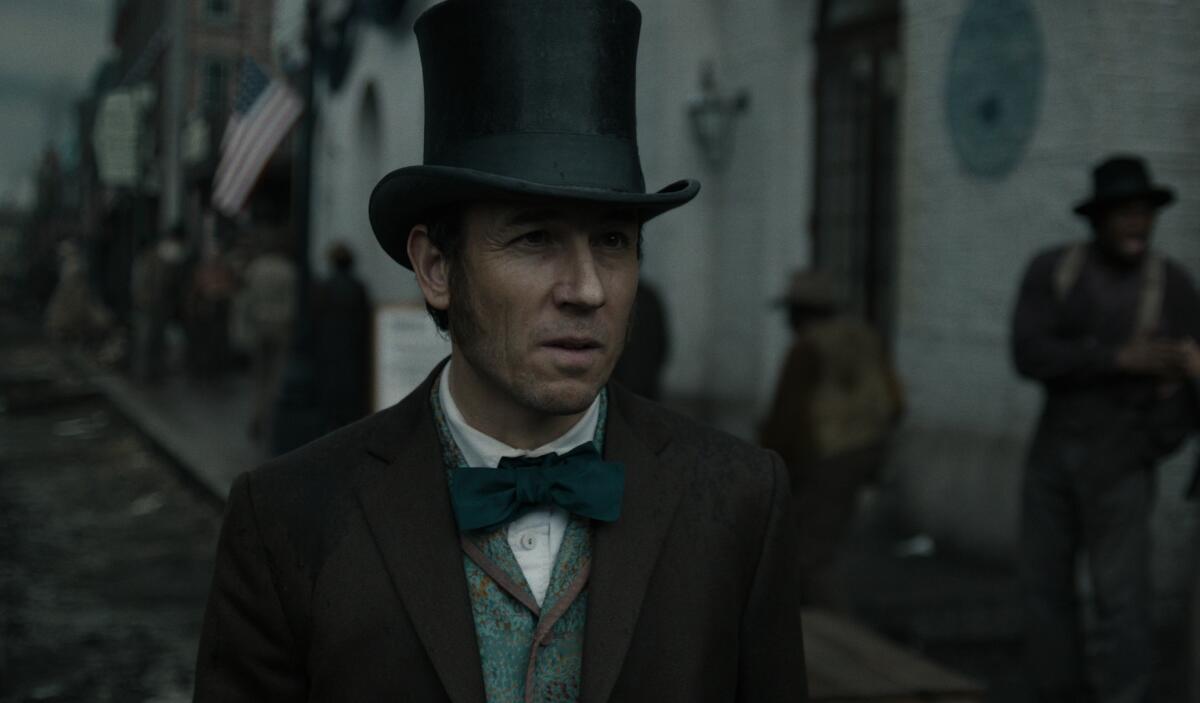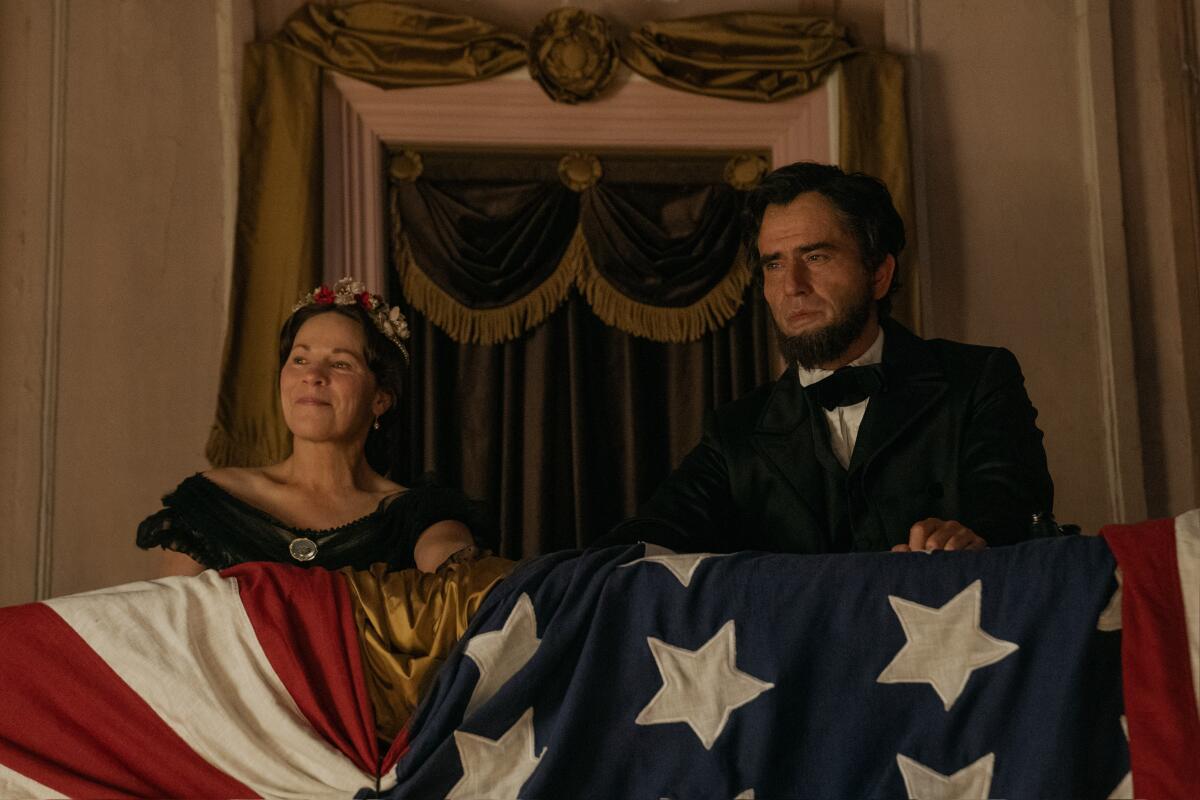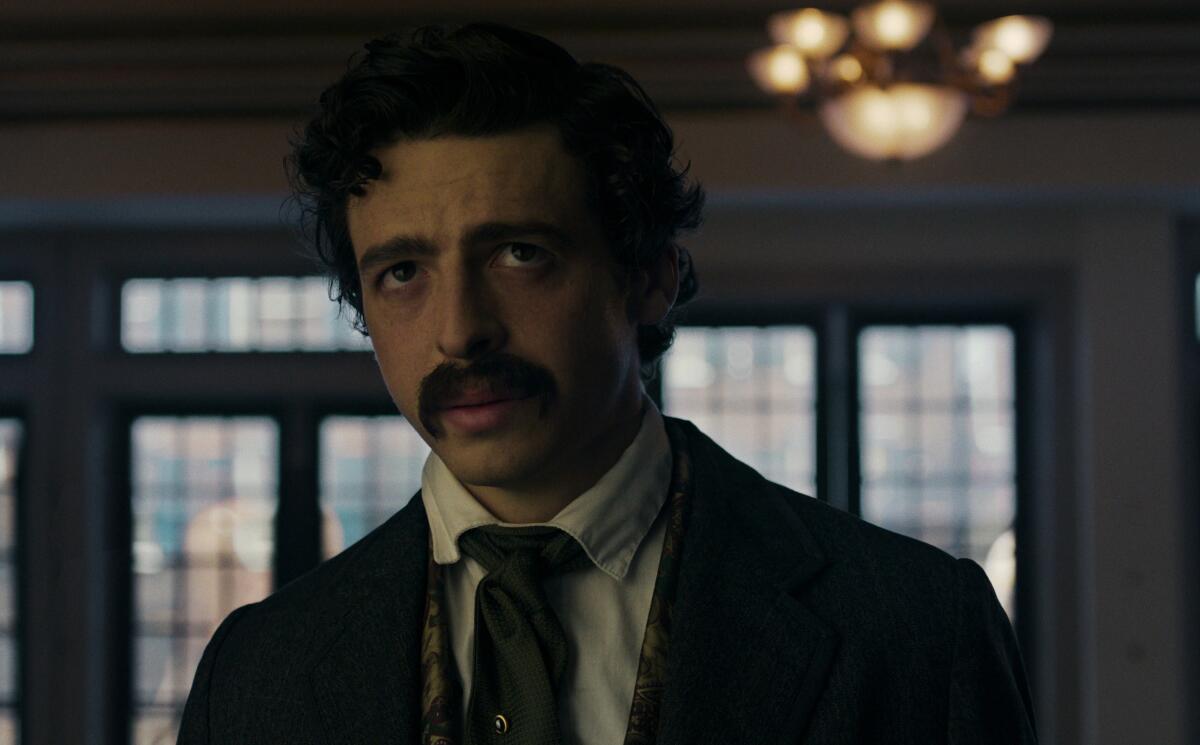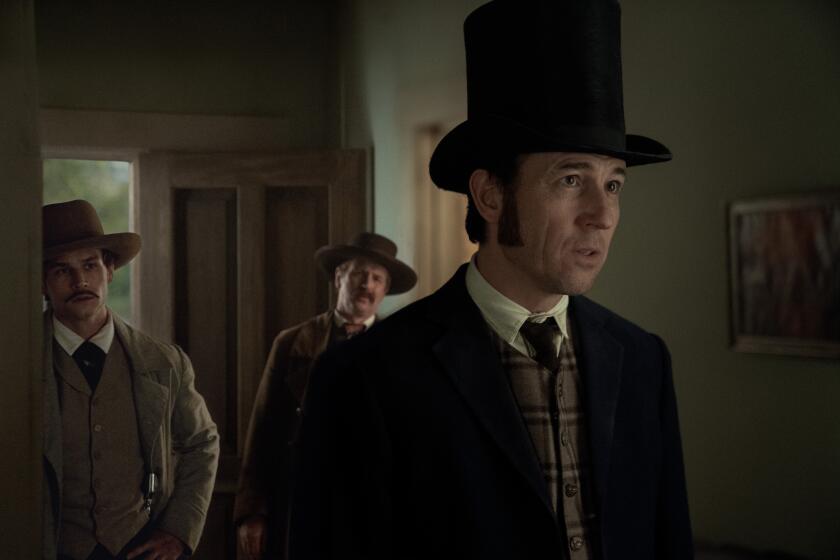Review: ‘Manhunt’ takes some liberties to depict the real-life chase for Lincoln’s killer

- Share via
Abraham Lincoln — perhaps you’ve heard of him? Sixteenth president of the United States, assassinated five days after the end of the Civil War at Ford’s Theatre. John Wilkes Booth. Sic semper tyrannis.
Well, I don’t know what they’re teaching in school these days, but I hope none of that is news to anyone. Even so, there’s always more to know. James L. Swanson’s 2006 book “Manhunt: The 12-Day Chase for Lincoln’s Killer,” which concentrates on the assassination and its aftermath, is one of thousands of deeply researched volumes on the president, his associates, his assassin and the assassin’s associates; as if to demonstrate a point, Swanson followed it with “Lincoln’s Assassins: Their Trial and Execution” and “Bloody Crimes: The Chase for Jefferson Davis and the Death Pageant for Lincoln’s Corpse.” Now, “Manhunt” — with supplementary sources — has been converted into a seven-episode docudrama by Monica Beletsky (“Parenthood,” Friday Night Lights”), premiering Friday on Apple TV+.
James L. Swanson’s bestselling book is the basis for Apple TV+’s “Manhunt,” but the cast and creator also turned to historical documents from the real people depicted.
“Manhunt” follows the broad lines and hits many particular points of the assassination and its aftermath, but, like all such translations, it takes liberties. Some of this is for dramatic effect, some to streamline, some to make political points and some of it, surely, is a matter of budget.

Beletsky’s “Manhunt,” though it branches out from Swanson’s focused telling, concentrates on Booth (Anthony Boyle) and his nemesis, Secretary of War Edwin Stanton (Tobias Menzies, from “Outlander” and “The Crown”), a Lincoln skeptic who eventually became the president’s bestie and coordinated the search for his killer. While Booth’s flight from Ford’s Theatre in Washington, D.C., adheres more or less to the well-known itinerary, the series makes Stanton present at all sorts of places he was not, doing things he never did in order to keep him a dramatically active character. “Have you ever met a problem you could delegate?” asks his wise, patient missus, Ellen (Anne Dudek).
Since England’s royal family shares so little of their personal opinions, actor Tobias Menzies relies on the script to explore Prince Philip.
Not surprising, the series, whose directors include Carl Franklin and John Dahl, both of whom specialize in mysteries and thrillers, is most successful when it frames Stanton as a detective — searching rooms, questioning witnesses, interrogating suspects, traveling north to Montreal hunting Confederate spies, riding south in search of Booth — and what’s more a detective in the “this time, it’s personal” mode. (I am guessing “This is a crime scene” are not words the secretary ever spoke, nor did anyone in 1865.) And he’s asthmatic, which adds extra drama to the drama.
Menzies, who plays him minus the historical Stanton’s impressive whiskers, the better to appear a 21st-century screen hero, catches his well-documented resolve, seriousness, impatience and impassive imperiousness. (“I’d pay to see you laugh,” says Lincoln, played by Hamish Linklater, offering Stanton his extra theater tickets.) He’s a hard-boiled brand of Cabinet secretary, with a set jaw and a steely gaze. All he needs is the trenchcoat; he has the gun.
More expressive and expansive is Booth, a popular actor from a family of actors, and a sad-eyed Boyle plays him, as seems to have been the case with the assassins of history, smaller than life but large in his own reckoning. (Twice people tell him he looks smaller in person.) He devours newspaper reports of the assassination — “I always read my reviews” — and keeps a diary that he hopes to see published when he escapes to a reborn Confederacy. David Herold (Will Harrison), his companion on the run, is not so much a conspirator as a love-struck flunky, and in a much revised account of Booth’s experience at Garrett’s farm, where he met his end, he flirts with the farmer’s daughter, who, nevertheless, recalling the old joke, makes him sleep in the barn. (The farmer is not at home.)

Apple TV+ is advertising “Manhunt” as a “conspiracy thriller” about “one of the best-known but least understood crimes in history.” That is not strictly true — it doesn’t really function as a thriller, and 16 decades of research, reporting and discussion have left it pretty well understood. (Though questions surrounding a bigger conspiracy do remain unsettled for some.)
But many of us will hear for the first time of some of these characters and their actions. Even the fact that Lincoln’s killing was only the main component in what was meant to be a three-pronged attack — including Secretary of State William Henry Seward (Larry Pine), who survived his, and Vice President Andrew Johnson (Glenn Morshower, banal and evil), whose designated assassin never showed — is often left out of the telling. (I can’t remember it coming up in history class, anyway.)
In addition, there’s been a concerted effort to broaden the pursuit with issues of emancipation and enfranchisement and the effects of slavery, giving screen time to Black characters and causes, rather than allowing this to be merely the story of one white man chasing another. Which seems just. Most significant is Mary Simms (Lovie Simone), a put-upon servant to Dr. Samuel Mudd (Matt Walsh), who set Booth’s broken leg; one of 10 Black people to testify at the conspirators’ trial, Simms is used to illustrate both Mudd’s racism and Booth’s, as well as issues of reconstruction and education. And there is Elizabeth Keckley (Betty Gabriel), a former slave who became dressmaker and confidant to Mary Todd Lincoln (Lili Taylor), helped found the Contraband Relief Assn. (“contraband” referring to Black refugees of undetermined status) and wrote the memoir “Behind the Scenes, or, Thirty years a Slave, and Four Years in the White House,” which are duly included. Her life could make a miniseries.
For the record:
1:47 p.m. March 15, 2024The quote “I could fire this on Wall Street in broad daylight and nothing would happen to me” originally said “on Broadway” and was misattributed to John Wilkes Booth.
And there are messages from the future. “I could fire this on Wall Street in broad daylight and nothing would happen to me,” says one villain, leveling a gun at Stanton. “This is America. We replace our presidents with elections, not with coups,” Stanton will at another point say.
Among other characters accounted for in a large cast of heroes and villains and bystanders are Joseph Holt, judge advocate of the U.S. Army, and Patton Oswalt as Det. Lafayette Baker, head of the National Detective Police. “Scoundrel” and “rogue” and “liar” are words that tend to attend Baker’s name, but here he comes across as Oswalt in a beard, which is to say, kind of sweet. And there’s Linklater’s unusually buoyant Lincoln, of course. The president was reported to be in an especially good mood in those few postwar days and had indeed expressed a desire to visit California, as he does here. (Probably, he did not say, “We could go to the beach.”)
The series is well furnished and costumed and moves with pep through its alternating scenes of action and reflection; it is various enough not to get dull. But it’s very much a TV show, with TV beats, made to entertain before it’s made to inform. The problem with any docudrama is that once you know a few things are wrong or fabricated, you begin to question the rest of it; I’m sure I am not the only viewer driven to fact-checking such programs and who will dive into Google or pick up Swanson’s book for comparison. It reminds one not to confuse such representations, filtered through writers and directors and actors, with fact.
But if it spurs you on to further research, so much the better. Learning is good and fun.
More to Read
The complete guide to home viewing
Get Screen Gab for everything about the TV shows and streaming movies everyone’s talking about.
You may occasionally receive promotional content from the Los Angeles Times.








